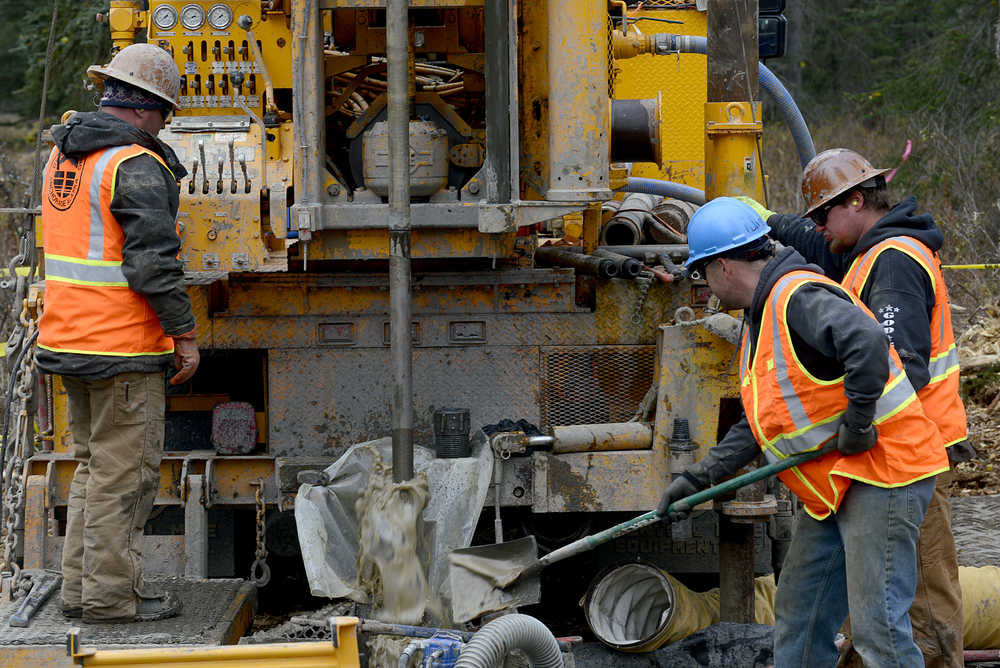Several reporters, industry representatives from ExxonMobil and the Alaska LNG project visited the Kenai Peninsula last week during a showcase of the research projects currently underway to determine whether Nikiski is a viable site for the terminus of a massive energy project.
On Thursday, Alaska LNG, a group with representatives from the state, oil companies and pipeline builders, flew several reporters to Nikiski where the group has been purchasing land and conducting geotechnical surveys near a site that could house a liquefaction plant for the project.
The Alaska LNG project concept would take natural gas from the North Slop near Prudhoe Bay and pipe it 800 miles to a plant site near Nikiski. Along the way, at least five domestic gas off-takes would be built on the pipeline.
It is unclear exactly where the plant would be located, and ExxonMobil’s Alaska LNG Senior Manager Steve Butt said it would take time to find the right spot.
Still, the consortium has been purchasing land in Nikiski, and several trees in area near Autumn Road, where reporters were taken to see a team perform core sampling work, were labeled with large red and white “No Trespassing” signs.
The area, located just east of the Agrium facility on the Kenai Spur Highway, is part of a several hundred acre land-buy the consortium has been carrying out for months.
“We’ve been dealing with more than 100 landowners,” Butt said. “We have contracts with several of them.”
He said it the land currently being acquired was “in excess of 300 acres.”
Ultimately, the group will need about 600 acres to build the plant, he said.
The plant would include three 42.3 million-gallon LNG storage tanks and be staffed by about 200 people during the day, according to the project overview.
For local landowners, the possibility of being forced to sell has loomed in recent weeks.
According to the Jan. 14 Heads of Agreement between the state, the Alaska Gasline Development Corporation, TransCanada Alaska Development, and three oil companies, the state is willing to use its eminent domain rights “to facilitate implementation of the Alaska LNG project.”
Butt said it was early in the process to be talking about the state using eminent domain and, there are other options available if the consortium cannot acquire the land it needs in the Nikiski .
“If it doesn’t work here, there are other sites where we’ll have to go,” he said. “We want to work with the owners here and say ‘OK, does that work for you?’ and hopefully those folks understand that they own the land that impacts the projects, but they’re also a citizen of the state and the state owns the project.”
Butt said other locations for the liquefaction plant could be on the east or west side of Cook Inlet, but would not specify.
“We believe this is the right place to start,” he said. “That’s why we’re doing this geotechnical work.”
In addition to core sampling near Nikiski, the consortium has hired three boats to perform underwater surveys to map areas of the Cook Inlet.
In order for the consortium to scrap plans to build a facility in Nikiski, Butt said the group would have to come across “something that implies we can’t get the land we need,” or “something that we learn in the geotechnical analysis that indicates putting the plant here would be imprudent.”
Butt said that ultimately, the use of eminent domain in Nikiski would be the state’s decision.
“As a project entity, we don’t want to use eminent domain,” he said. “We want fair and durable relations with the community where we are going to end up, because the plant is going to be there for 30-plus years.”
Another group in the area who could find themselves affected by the project, which Butt estimated could cost between $45-65 billion to build, are setnet fishermen whose beach sites line the east side of Cook Inlet.
Alongside the plant, which would sit at the end of the pipeline and chill natural gas into liquid form, a jetty would be built to accommodate tankers where the gas will be stored and then exported from the state.
Between 15-18 tankers are expected to be in transit between the port and Asia, with one or two on call at the jetty at a time, Butt said.
Butt said The U.S. Department of Homeland Security would likely get involved when decisions about access to land the near the facility became an issue.
But, the project is in its early planning stages and it is not yet clear how much land, and who, will be affected by the liquefaction facility.
“We don’t know and we won’t know for a couple of years,” he said.
Currently the project is in a pre-design and engineering phase, it could take 5-6 years for construction to begin.
Rashah McChesney can be reached at rashah.mcchesney@peninsulaclarion.com.

